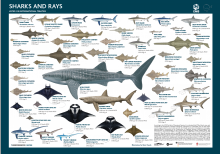Information Hub - Awareness Raising

The Devil and Manta Rays (family Mobulidae, the Mobulid Rays) are slow-growing, large-bodied animals with some species occurring in small, highly fragmented populations. Mobulid Rays are pelagic filterfeeders, with populations sparsely distributed across tropical and warm temperate oceans.

The White Shark (Carcharodon carcharias) inhabits coastal and offshore pelagic waters of subtropical and temperate seas. White Sharks have low fecundity, and females attain sexual maturity at a late age (33 years). Based on bomb radio-carbon signatures, the maximum age of White sharks is up to 73 years.

The Great Hammerhead (Sphyrna mokarran) and Scalloped Hammerhead (Sphyrna lewini) sharks are long lived, late maturing, and relatively slow growing. Great Hammerhead Sharks can live to up to 44 years and have a gestation period of 11 months producing 6-33 pups biennially. Scalloped Hammerhead Sharks can live to up to 35 years and have a gestation period of 8-12 months producing 15-31 pups biennially.

The Shortfin Mako Shark (Isurus oxyrinchus) and the Longfin Mako Shark (Isurus paucus) occupy epipelagic habitats in tropical and warm-temperate seas. As a long-lived species (at least 30 years) with low fecundity (11 young every 3 years) and late age at maturity, population recovery times for Shortfin Mako are slow.

The Porbeagle (Lamna nasus) occupies epipelagic habitats in temperate seas. They live up to 65 years with low fecundity and a female age at maturity of 13-17 years. Population growth rate is low but juvenile survival rates are high.

The family Pristidae consists of five Sawfish species Narrow Sawfish (Anoxypristis cuspidata), Dwarf Sawfish (Pristis clavata), Smalltooth Sawfish (Pristis pectinata), Largetooth Sawfish (Pristis pristis) and Green Sawfish (Pristis zijsron). They range in maximum length from 3 m to over 7 m. Life history information is limited.

The Spiny Dogfish (Squalus acanthias), also known as Picked Dogfish or Spurdog, is a demersal shark that has a maximum length of 125 cm in the North Atlantic. It occurs mostly in shelf seas, from coastal habitats to the shelf edge, but can occur to depths of 900 m.

All three species of Thresher Shark belong to the genus Alopias and include the Pelagic (Alopias pelagicus), Bigeye (Alopias superciliosus) and Common (Alopias vulpinus) Thresher. All three species have biological characteristics that result in low productivity, Bigeye Thresher, in particular, is one of the less productive pelagic shark species, due to the very low fecundity and late maturity for females.

The Whale shark (Rhincodon typus) is the world’s largest living fish, found globally in tropical and warm temperate waters. Coastal feeding aggregations are known from these filter feeders, where they exploit seasonal productivity of pelagic invertebrates, fish spawning events, and small schooling fishes.

The Silky Shark (Carcharhinus falciformis) is an abundant, oceanic and epipelagic shark. The Silky Shark can be characterized as a long lived (up to 30 years) species, relatively slow growing, and maturing at between 5-10 years of age. Depending on the study, litter size ranges from 2- 25 individuals.

The Basking Shark (Cetorhinus maximus) is a large subtropical to temperate water species. It is a filter-feeder, and often forages around frontal systems and other oceanographic features with high densities of zooplankton.

These factsheets about human impacts on sharks and rays, authored by Simon J Pierce and Ryan Charles, address the five most important threats to sharks and rays, (1) overfishing, (2) climate change, (3) pollution, (4) tourism, and (5) habitat modification. The fact sheets have been prepared for CMS by the IUCN Species Survival Commission (SSC) Shark Specialist Group, with funding provided by the government of Germany and the Principality of Monaco and with technical support from the Sharks MOU Advisory Committee.




